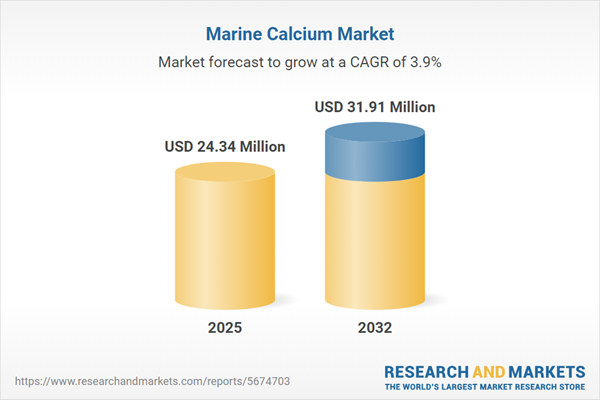Speak directly to the analyst to clarify any post sales queries you may have.
Senior leaders in the marine calcium market face increased complexity, as evolving regulations and mounting sustainability pressures drive the need for smarter business models and forward-looking strategies. Today’s decision-makers must align innovation, regulatory navigation, and efficient operations to support enduring market growth and resilience.
Market Snapshot: Marine Calcium Market Size, Growth Drivers, and Opportunities
The global marine calcium market reached USD 23.44 million in 2024, achieving a 3.93% compound annual growth rate (CAGR). This expansion is fueled by rising demand for bone health, preventive nutrition, and holistic wellness solutions in both consumer and industrial domains. An ageing population and the growth of middle-class consumers worldwide are changing consumption patterns, leading to increased use of marine calcium in dietary supplements, animal nutrition, fortified foods, and the cosmetics sector. Manufacturers are leveraging advances in extraction technology and prioritizing transparency, which enhances compliance with strict regulatory and sustainability requirements. These shifts are enabling companies to access new geographic regions, set themselves apart in premium categories, and explore strategic alliances for business development.
Scope & Segmentation: Marine Calcium Market
- Form Options: The category includes capsules, liquids, tablets, microencapsulated materials, and conventional powders, giving brands tools to build targeted wellness products for distinct demographic groups and application needs.
- Application Areas: Marine calcium finds use in animal feed, dietary supplements, bakery products, confectionery, cosmetics, and functional beverages, aligning with trends in food fortification, personal wellness, and animal health.
- Distribution Channels: Products are available through grocery stores, hypermarkets, specialty retailers, online marketplaces, and pharmacies, ensuring expanded routes to market and access for both traditional and digital buyers.
- Source Materials: Sourcing primarily from coral, eggshell, and limestone supports regional sustainability priorities and facilitates compliance with evolving environmental and quality benchmarks in established and emerging regions.
- End Users: Solutions are tailored to adults, children, livestock, and companion animals, adapting to diverse health requirements across human and animal nutrition, as well as sector-specific standards.
- Geographical Coverage: The market spans the Americas, Europe, Middle East, Africa, and Asia-Pacific, with regional markets influenced by unique consumption trends, regulatory policies, and logistical demands that shape go-to-market strategies.
- Company Profiles: Leading organizations such as Koninklijke DSM N.V., BASF SE, DuPont de Nemours, Cargill, Lonza Group, Merck KGaA, Glanbia PLC, Ajinomoto Co., Ingredion, and Kerry Group are driving sector innovation and responding to diverse policy frameworks and logistics requirements.
Key Takeaways: Strategic Insights for Marine Calcium Market Decision-Makers
- Advanced extraction methods, including enzymatic and ultrasonic processes, position companies to meet higher compliance standards and enhance the quality of nutraceutical and cosmetic products.
- Adoption of microencapsulation increases product stability and bioavailability, opening opportunities for differentiated functional foods and new supplement categories.
- The integration of blockchain and recognized eco-certifications across supply chains promotes transparency, reduces risk, and strengthens credibility with business partners and institutional stakeholders.
- Utilizing direct-to-consumer or digital-first sales approaches allows providers to adjust rapidly to shifting purchasing behaviors and form deeper engagement with targeted customers.
- Establishing strategic collaborations with biotechnology firms or aquaculture suppliers reinforces security of supply and operational resilience in unpredictable regulatory or competitive environments.
- Diversifying into adjacent markets or product segments supports quicker adaptation to changing customer and policy demands, contributing to more sustainable long-term growth.
Tariff Impact: Navigating Policy Changes and Cost Control
Recent US tariffs have driven businesses in the marine calcium industry to reconfigure supply chains, invest in local processing, strengthen supplier agreements, and opt for domestic sources like eggshell and limestone. These strategic adjustments contain cost volatility and help preserve operational stability amid regulatory shifts.
Methodology & Data Sources
This market analysis combines interviews with industry leaders, reviews of current trade publications, and validated primary and secondary data. All sources undergo expert analysis to ensure insights are practical and relevant for executive decision-making in the marine calcium market.
Why This Report Matters
- Enables procurement leaders and executive teams to secure supply chain partnerships, increasing agility and resilience in marine calcium sourcing and distribution.
- Provides actionable intelligence on technological and sustainability developments, supporting compliance and adaptation to policy or consumer requirements.
- Enhances strategic planning for market entry, portfolio extension, and regional growth, aligned with sector-specific business and regulatory goals.
Conclusion
Securing sustainable growth in the marine calcium sector requires continuous investment in technology, agile supply chain strategies, and consistent alignment with evolving regulatory standards.
Additional Product Information:
- Purchase of this report includes 1 year online access with quarterly updates.
- This report can be updated on request. Please contact our Customer Experience team using the Ask a Question widget on our website.
Table of Contents
3. Executive Summary
4. Market Overview
7. Cumulative Impact of Artificial Intelligence 2025
Companies Mentioned
The companies profiled in this Marine Calcium market report include:- Koninklijke DSM N.V.
- BASF SE
- DuPont de Nemours, Inc.
- Cargill, Incorporated
- Lonza Group AG
- Merck KGaA
- Glanbia PLC
- Ajinomoto Co., Inc.
- Ingredion Incorporated
- Kerry Group plc
Table Information
| Report Attribute | Details |
|---|---|
| No. of Pages | 184 |
| Published | October 2025 |
| Forecast Period | 2025 - 2032 |
| Estimated Market Value ( USD | $ 24.34 Million |
| Forecasted Market Value ( USD | $ 31.91 Million |
| Compound Annual Growth Rate | 3.9% |
| Regions Covered | Global |
| No. of Companies Mentioned | 11 |









